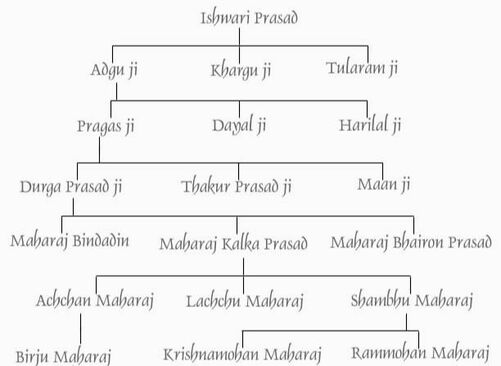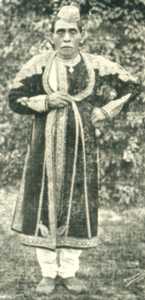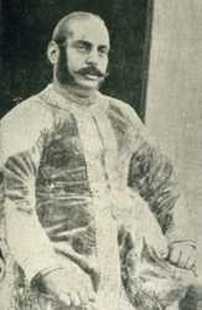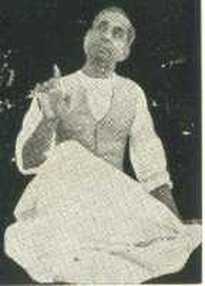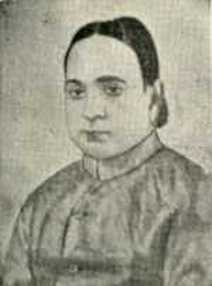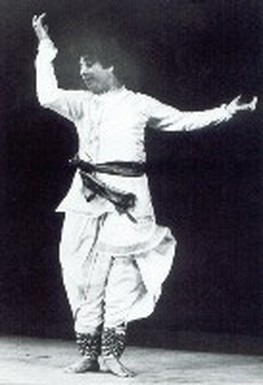Ancestors
Image : First seven generations of Lucknow Gharana
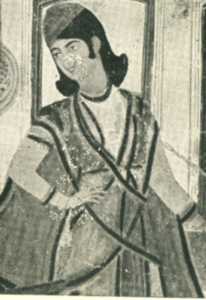
Maharaj Thakur Prasad
Pandit Birju Maharaj is a direct descendant of Ishwari Prasadji, the first known Kathak teacher. Sri Ishwari Prasadji was a Mishra Brahmin in Handia Tehsil of Allahabad. It is said that Lord Krishna appeared in his dream and asked him to re-establish Kathak Nritya (Natwari Nritya). He passed on his knowledge to his sons Adguji, Kharguji and Tularamji, by teaching them Kathak till the ripe old age of 100 years. The three sons also devoted their life to this tradition and passed it on to their sons.
Adguji had three sons - Prakashji, Dayalji and Harilalji - who received complete training from their father. After his father’s death Prakashji came to Lucknow, along with his two brothers, and was appointed the court dancer by Nawab Asafuddaulah. Prakashji had three sons – Maharaj Durga Prasad, Maharaj Thakur Prasad and Maharaj Maan Prasad. It is said that the King bestowed the title of ‘Singh’ upon Maanji who then became Maan Singhji.
Maharaj Thakur Prasad was the Kathak Guru of Nawab Wajid Ali Shah and it is said that he received four Palkis full of money as Guru Dakshina. He gave Kathak the name ‘Kathak Natwari Nritya’. Maharaj Durga Prasad had three sons – Bindadin, Kalka Prasad and Bhairon Prasad.
Adguji had three sons - Prakashji, Dayalji and Harilalji - who received complete training from their father. After his father’s death Prakashji came to Lucknow, along with his two brothers, and was appointed the court dancer by Nawab Asafuddaulah. Prakashji had three sons – Maharaj Durga Prasad, Maharaj Thakur Prasad and Maharaj Maan Prasad. It is said that the King bestowed the title of ‘Singh’ upon Maanji who then became Maan Singhji.
Maharaj Thakur Prasad was the Kathak Guru of Nawab Wajid Ali Shah and it is said that he received four Palkis full of money as Guru Dakshina. He gave Kathak the name ‘Kathak Natwari Nritya’. Maharaj Durga Prasad had three sons – Bindadin, Kalka Prasad and Bhairon Prasad.
Bindadin Maharaj started rigorous dance training at the a very early age. He practiced Tatkar for 12 hours a day - everyday - for four years. He wrote and composed about 3000 Thumris and created beautiful Bhav on them. He taught Thumri singing to many famous singers and court dancers. He along with his younger brother Kalka Prasad were famous as’ Kalka-Bindadin ki jodi’ (the Kalka-Bindadin twosome) and gave successful performances all over India. They were also known as ‘Ram-Lakshman’.
Though Kalka Maharaj died well before Bindadin Maharaj, they are both revered as the founders of modern-day Kathak. Kalka Maharaj had three sons - Achchan Maharaj, Lachhu Maharaj, and Shambhu Maharaj.
Aacchan Maharaj was born in Lamuha near Sultanpur. He received training from Kalka Prasadji and Bindadinji and was an expert of Bhav, Laya as well as Taal. Even though he was heavy in stature he could take chakkars (pirouette) very easily and gracefully. He was a very good natured person, hence known as ‘Achhan’ Maharaj.
Shambhu Maharaj was tied the Ganda by Bindadin Maharaj, at the age of eight. At his death-bed Bindadin Maharaj gave Shambhu Maharaj’s hand in the hand of Acchan Maharaj and told him to treat his younger brother like his son and train him well. At the age of 13 his mother sent him for Thumri training under Ustaad Rahimmuddin Khan, and at the age of 14 his mother brought him to Rampur estate, where Acchan Maharaj was the court dancer. He received training from him for 4 years, after which he came to Lucknow and propagated Kathak.
Aacchan Maharaj was born in Lamuha near Sultanpur. He received training from Kalka Prasadji and Bindadinji and was an expert of Bhav, Laya as well as Taal. Even though he was heavy in stature he could take chakkars (pirouette) very easily and gracefully. He was a very good natured person, hence known as ‘Achhan’ Maharaj.
Shambhu Maharaj was tied the Ganda by Bindadin Maharaj, at the age of eight. At his death-bed Bindadin Maharaj gave Shambhu Maharaj’s hand in the hand of Acchan Maharaj and told him to treat his younger brother like his son and train him well. At the age of 13 his mother sent him for Thumri training under Ustaad Rahimmuddin Khan, and at the age of 14 his mother brought him to Rampur estate, where Acchan Maharaj was the court dancer. He received training from him for 4 years, after which he came to Lucknow and propagated Kathak.
Pt. Birju Maharaj was born on 4 February 1938 in Lucknow, where his father, Acchan Maharaj, recognized his talent and took him under his guidance. His uncles, Shambhu Maharaj and Lachhu Maharaj also taught him Kathak at an early age.
Childhood
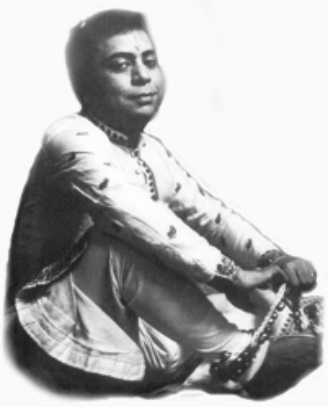
Acchan Maharaj spent most of his time practicing his art and teaching his students and Birju Maharaj still a small child, imbibed a great deal by observing. Recognizing the inborn talent of his son, Acchan Maharaj gave him the opportunity of performing with him at an early age. Even though Acchan Maharaj passed away when Birju was nine years old, he left an indelible mark on him.Pt. Birju Maharaj was born on 4 February 1938 in Lucknow. Initially his name was ‘Dukh Haran’, which was later changed to ‘Brijmohan’, a synonym of Krishna. Brijmohan Nath Misra was shortened to ‘Birju’, which remains the name he is fondly known by.
Surrounded by a musical atmosphere, his inborn talent surfaced at the early age of three years, when he would playfully sit on his father’s lap and recite tihais and tukras, oblivious of the fact that they were complex pieces.
The sound of the music and dance emanating from the taalimkana (classroom) was enough inspiration for young ‘Birju’ to devote himself wholeheartedly to dance. Though he was too young to receive formal training, he would watch carefully when his father taught his disciples. Acchan Maharaj recognized the talent and took him under his guidance.
His father performed at musical conferences all over India and by the age of seven, Birju Maharaj had accompanied him to Kanpur, Allahabad, Gorakhpur, Jaunpur, Dehradun, and even far off places like Madhubani, Kolkata and Mumbai. He got the opportunity to share the platform with his illustrious father, who allowed him to present a few pieces before he himself came on stage.
Acchan Maharaj shifted to Delhi to teach at Sangeet Bharti. Birju Maharaj, then eight years old, enthusiastically imbibed all activities at the centre. He became proficient at dancing, singing and playing the tabla. Acchan Maharaj shifted back to Lucknow with the family due to the communal riots, which raged all over the country during the pre-independence period.
His father died soon after leaving nine-year-old Birju under the guidance of Shambhu Maharaj. The following years were full of struggle and household goods were sold to make ends meet. He spent about ten months in Mumbai learning from his uncle Lacchu Maharaj. At the young age of thirteen, he was invited to join Sangeet Bharti in Delhi to teach Kathak. Soon he established himself as a good dancer and dedicated teacher.
Surrounded by a musical atmosphere, his inborn talent surfaced at the early age of three years, when he would playfully sit on his father’s lap and recite tihais and tukras, oblivious of the fact that they were complex pieces.
The sound of the music and dance emanating from the taalimkana (classroom) was enough inspiration for young ‘Birju’ to devote himself wholeheartedly to dance. Though he was too young to receive formal training, he would watch carefully when his father taught his disciples. Acchan Maharaj recognized the talent and took him under his guidance.
His father performed at musical conferences all over India and by the age of seven, Birju Maharaj had accompanied him to Kanpur, Allahabad, Gorakhpur, Jaunpur, Dehradun, and even far off places like Madhubani, Kolkata and Mumbai. He got the opportunity to share the platform with his illustrious father, who allowed him to present a few pieces before he himself came on stage.
Acchan Maharaj shifted to Delhi to teach at Sangeet Bharti. Birju Maharaj, then eight years old, enthusiastically imbibed all activities at the centre. He became proficient at dancing, singing and playing the tabla. Acchan Maharaj shifted back to Lucknow with the family due to the communal riots, which raged all over the country during the pre-independence period.
His father died soon after leaving nine-year-old Birju under the guidance of Shambhu Maharaj. The following years were full of struggle and household goods were sold to make ends meet. He spent about ten months in Mumbai learning from his uncle Lacchu Maharaj. At the young age of thirteen, he was invited to join Sangeet Bharti in Delhi to teach Kathak. Soon he established himself as a good dancer and dedicated teacher.
Family
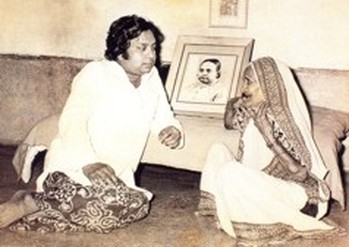
Pt. Birju Maharaj with Ammaji
Birju Maharaj’s mother Amma ji lived at the ancestral house in Lucknow. Having lost his father at a very young age, he was very devoted to his mother. Even after shifting to Delhi he spent the summer holidays with her, patiently listening to tales of the days gone by, of his childhood and the brief period spent with his father.
As was the custom of the times, the women stayed in purdah and had nothing whatsoever to do with dance. Since the sounds of music and dance were a part of her surroundings, Amma, remembered a surprising number of musical compositions of those times. Coaxed by her son she sometimes came forward with uncommon and previously unheard lyrics, singing them coyly. In this way, Maharaj ji came in possession of some invaluable compositions and got glimpses of his childhood, through his mother’s eyes. Respected by everyone, she continued to live at the ancestral house in Lucknow until her demise
As was the custom of the times, the women stayed in purdah and had nothing whatsoever to do with dance. Since the sounds of music and dance were a part of her surroundings, Amma, remembered a surprising number of musical compositions of those times. Coaxed by her son she sometimes came forward with uncommon and previously unheard lyrics, singing them coyly. In this way, Maharaj ji came in possession of some invaluable compositions and got glimpses of his childhood, through his mother’s eyes. Respected by everyone, she continued to live at the ancestral house in Lucknow until her demise
Children
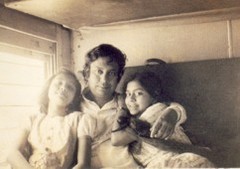
Pt. Birju Maharaj has three daughters Kavita, Anita and Mamta and two sons Jaikishan and Deepak. Kavita though a very talented dancer learnt only for her creative satisfaction and never took it up professionally. Anita is a painter and artiste. Jaikishan, Deepak and Mamta are professional Kathak dancers, carrying forward the family tradition. Mamta is more inclined towards teaching while Jaikishen is an established choreographer in his own right. Deepak, the youngest of the five, holds considerable promise as a solo dancer.
